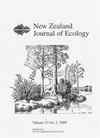追踪相机增强了对偏远高山环境中蜥蜴行为的了解
IF 1.4
3区 环境科学与生态学
Q3 ECOLOGY
引用次数: 0
摘要
一个物种所面临的威胁的数量和类型往往受其活动模式的影响。对于变温动物来说,环境条件可能会强烈影响活动,因为需要外部热量才能达到促进生理功能(包括运动)的体温。因此,人们可能会认为变温动物会避开寒冷的环境,比如高山地区,因为那里的温度变化很大,冬天很长。然而,许多特有的蜥蜴,包括昼行蜥蜴(Oligosoma spp.),生活在新西兰奥特罗阿的高山地区。在南岛南部的高山带(c. 44°S; c. 44°S; c. 44°S;海拔1150 - 1600米),从春季到秋季。我们的问题是:(1)石龙子是在什么环境条件下出现的?(2)哪些温度和其他天气变量促进地表活动的最高水平?(3)典型的活动类型和持续时间是什么?当温度较暖时,我们观察到更多的皮肤子活动,95%的皮肤子观察发生在铜模型记录的温度在13.2至43.2°C之间;这些模式遵循在低海拔的麦肯石龙子和澳大利亚高山石龙子物种中观察到的趋势。此外,石龙子在干燥和阳光充足的情况下最活跃,在仲夏的下午晚些时候达到顶峰。当可见时,石龙子非常灵活,只在同一个位置停留1-3分钟。我们的研究增加了对高山环境中通才石龙子的理解。在夏季,石龙子的活动高度依赖于温暖的阳光条件,我们的研究强调了跟踪摄像机是在这种偏远环境中监测行为(包括潜在捕食者暴露)的有效工具。本文章由计算机程序翻译,如有差异,请以英文原文为准。
Trail cameras enhance understanding of lizard behaviour in a remote alpine environment
: The number and type of threats that a species is exposed to is often influenced by their activity patterns. For ectotherms, environmental conditions are likely to strongly influence activity, given that external heat is needed to reach body temperatures that promote physiological functions, including locomotion. As a result, one might expect ectotherms to avoid cold environments, such as the alpine zone, known for large temperature variations and prolonged winters. However, many endemic lizards, including diurnal skinks ( Oligosoma spp.), inhabit the alpine zone across Aotearoa, New Zealand. We used trail cameras to monitor the surface activity of skinks (likely to be predominantly McCann’s skinks, Oligosoma maccanni ) in the alpine zone of the southern South Island (c. 44 ° S; 1150 to 1600 m a.s.l.) from spring until autumn. We asked: (1) under which environmental conditions do skinks emerge? (2) which temperatures and other weather variables promote the highest levels of surface activity? and (3) what sort and duration of activity are typical? We observed more skink activity when temperatures at basking locations were warm, with 95% of skink observations occurring when temperatures recorded at copper models were between 13.2 and 43.2°C; these patterns follow trends observed in McCann’s skinks at lower elevation and in species of alpine skinks in Australia. Furthermore, skinks were most active when conditions were dry and sunny, with observations in mid-summer peaking in the late afternoon. When visible, skinks were very mobile, only remaining in the same position for 1–3 min. Our study increases understanding of a generalist skink in an alpine environment. During summer, activity of skinks is highly dependent on warm sunny conditions, and our study highlights trail cameras as an effective tool for monitoring behaviour (including potential predator exposure) in this remote environment.
求助全文
通过发布文献求助,成功后即可免费获取论文全文。
去求助
来源期刊

New Zealand Journal of Ecology
环境科学-生态学
CiteScore
3.00
自引率
12.50%
发文量
35
审稿时长
>36 weeks
期刊介绍:
The New Zealand Journal of Ecology is a biannual peer-reviewed journal publishing ecological research relevant to New Zealand/Aotearoa and the South Pacific. It has been published since 1952 (as a 1952 issue of New Zealand Science Review and as the Proceedings of the New Zealand Ecological Society until 1977). The Journal is published by the New Zealand Ecological Society (Inc.), and is covered by Current Contents/Agriculture, Biology and Environmental Science, GEOBASE, and Geo Abstracts.
 求助内容:
求助内容: 应助结果提醒方式:
应助结果提醒方式:


